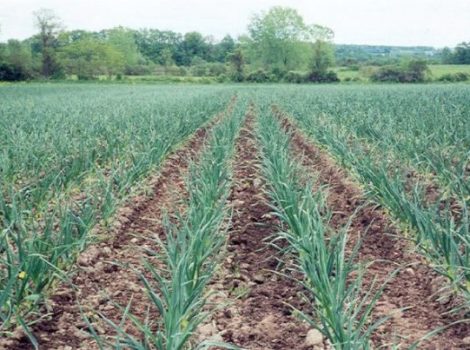Content
- 1 Seed preparation
- 2 Sowing dates
- 3 Growing conditions
- 4 Site preparation
- 5 Seedling method of growing
- 6 Growing without picking
- 7 Landing in open ground
- 8 Seedless way
- 9 Top dressing and care
- 10 Pest control
- 11 Growing early cabbage in a greenhouse
- 12 Harvesting
- 13 Important rules
- 14 How to choose and prepare white cabbage seeds?
- 15 Soil preparation for sowing and seedlings
- 16 How to properly plant white cabbage seedlings
- 17 Necessary conditions for growing white cabbage
- 18 What is the peculiarity of growing cabbage in a seedless way?
Cabbage is a very important crop that has been grown since time immemorial. Nowadays, there are more than ten of its types and many varieties.
Cabbage contains many useful substances: proteins, fiber, vitamins, macro- and microelements. Regular consumption of any varieties of cabbage is a good prevention of cancer and cardiovascular diseases. Cabbage is useful for various diseases, such as anemia, various infections, skin diseases, etc. In addition, cabbage leaves are used in the form of compresses for various wounds, headaches, and upper respiratory tract diseases.

Many gardeners are interested in how to grow early cabbage on their site. It is quite simple, this culture does not require special growing conditions.
Seed preparation
Growing early cabbage begins with the preparation of seeds, which must be sorted and disinfected. To do this, they must first be placed in hot water for 20 minutes, then in cold water for one or two minutes and dried. If you purchased seeds from a store, then there is no need for such preparation.
Before planting, it is advisable to soak the seeds of early cabbage and harden them at a temperature of + 1 ... +2 ° С for about a day. Thanks to this, they will germinate faster, in addition, such preparation increases the cold resistance of the plants.
Sowing dates
Planting dates depend on what kind and type of early cabbage. When is the best time to sow to get a good harvest?
Early varieties of white and red cabbage for seedlings are sown at the end of March, broccoli and cauliflower - from mid-March to late April, Brussels sprouts - from mid to late April. It is very important to take into account climatic conditions.
Growing conditions
It is necessary to take into account several important points in order for early cabbage to grow and develop well. Planting and care for the different varieties are mostly similar. Cabbage cannot be grown in the same place for more than three years. It gives a good harvest in areas where legumes, beets, tomatoes, onions, potatoes, cucumbers were previously grown.

Any types of this culture are well suited for fertile, light loamy, sandy loam, sod-podzolic, peat soils with an acidity close to neutral. A good harvest will not be obtained on sandy and heavy clay soil.
The site must be open and well lit.
Site preparation
Of great importance is the preparation of the site on which the early cabbage will grow. Planting and caring for plants begins in the spring. The site for early cabbage must be prepared in the fall. To do this, it is dug up and fertilized. As fertilizers, it is effective to use humus, manure and compost in the amount of 1-1.5 buckets per m2.
In addition, mineral fertilizers are added in the amount of 40 g of superphosphate per 1 m2 and half as much potassium chloride. The acidic soil is limed.
With the arrival of spring, the land on which the early cabbage will be planted is dug up, loosened and fertilized. Manure (one bucket per square meter) and wood ash (1-2 tbsp. Per square meter) are used as fertilizers.
Seedling method of growing
Growing early cabbage from seedlings allows you to get a good harvest. Seeds are sown in boxes filled with soil, which must first be leveled and watered. Then furrows are made with a depth of about 1.5 cm, in which the seeds are sown at a distance of 2 cm. Until the shoots appear, it is necessary that the temperature in the room be about 20 ° C. When the seeds sprout, the temperature is lowered to 8 ° C and maintained at this level for a week, after which it must be raised to 16-18 ° C during the day and about 10 ° C at night.
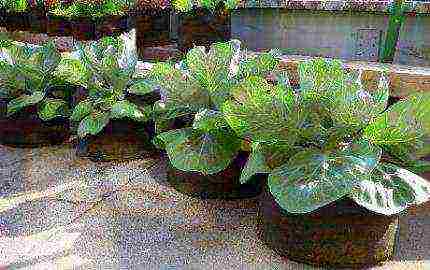
After two leaves appear, pick the seedlings into separate containers. It is important to consider that for good growth and development, cabbage needs additional lighting.
After the appearance of 5-6 true leaves, the seedlings are planted in open ground.
Growing without picking
When planting early cabbage for seedlings in this way, use cups, peat tablets, pots or special trays. Two seeds must be sown in each container or cell. When shoots appear, only the strongest plant is left.

Landing in open ground
When the air temperature exceeds 17 ° C and the soil temperature is 14 ° C, early cabbage seedlings are planted in the ground.
Seedlings of different varieties are planted according to different schemes:
- early white and red cabbage - 30 × 40;
- broccoli cabbage - 30 × 60, in order to develop lateral shoots - 40 × 60;
- Brussels sprouts - 60 × 70;
- early kohlrabi - 30 × 40;
- Savoy cabbage - 70 × 30;
- early cauliflower - 30 × 60.
It is best to plant cabbage in cloudy or rainy weather. In order to prevent the soil from compaction and crusting, it must be regularly mulched or loosened.
Seedless way
With this method of growing early cabbage, seeds are sown directly into the ground. Growing early cabbage using this method has its advantages. The plant does not have to be transplanted, the development of the root and aerial part occurs faster than with the seedling method of growing, the yield increases. Sowing of early cabbage is carried out at different times, depending on the region of growth.

Before planting, to protect against pests, seeds are treated with 12% hexachlorane. Seeding rate - 2 kg per 1 hectare, planting depth - 2-3 cm.
After the plant has 4-5 true leaves, the cabbage is thinned out, leaving one plant at a distance of 40-50 cm from the other. Further care is the same as when growing with the help of seedlings: watering, loosening, protection from pests.
Top dressing and care
How the leaves will grow and what size the head will be depends on how well the plant is supplied with nitrogen. Cabbage has a special need for nitrogen before the beginning of the formation of the head of cabbage. When the head of cabbage begins to set, the plant needs potassium.
A week after the seedlings have been planted, they need to be fed using a urea solution (for feeding ten plants - 3 tablespoons per 1 bucket of water), before setting the head of cabbage, nitrophoska is used for feeding (the same proportions for five plants).
Using organic fertilizers for feeding, their solution is prepared a day before feeding. The container is half filled with bird droppings, filled with water. The fertilizer must be stirred several times a day until a homogeneous liquid is obtained. Immediately before feeding, the liquid must be diluted ten times with water.
Cabbage loves moisture, so it is necessary to prevent the soil from drying out. Early cabbage is watered three to four times a week. Before harvesting, if further storage is expected, watering is stopped 35-45 days before.
After watering, the soil must be loosened, each time reducing the depth of treatment so as not to damage the root system. In order for a healthy early white cabbage to grow, it must also be covered with soil, but not with dry soil.
Pest control
Insects and other pests can cause irreparable damage to the crop, so plant protection must be taken care of.
Early white cabbage, as well as cauliflower, can be damaged by the cabbage fly, the larvae of which damage the roots of the plant. In this case, cabbage begins to wilt in hot weather, and its lower leaves become bluish.
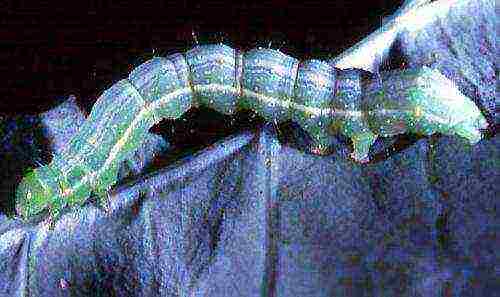
To combat this pest, DDT dust or 6% hexachlorane dust is used, which is used to pollinate the plant after planting. The procedure is carried out two to three times with an interval of a week. The soil is watered using 30% thiophos (concentration - 0.03%). You can sprinkle the ground near the plant with mothballs mixed with sand (1: 5).
A plant that has just begun to sprout can be damaged by a cruciferous flea that feeds on cabbage leaves. Early sowing and planting of seedlings can protect against this pest, which makes it possible for the plants to get stronger before the flea is activated. To accelerate growth and increase resistance, the plant is fed using saltpeter and slurry.
Cabbage whitefish (a white butterfly with wings in black spots) can also damage the plant. Caterpillars emerge from the eggs that are laid on the underside of the leaf. Spreading over the plant, they feed on leaves, eating them to coarse veins. In the fight against cabbage white, the same means are used as for cabbage moth.
Colonies of cabbage aphids, which suck the juices from the plants, cause enormous harm to the plant. The leaves then become covered with spots, begin to curl. The growth of cabbage slows down, the set of the head of cabbage stops.
To combat this pest, before setting the head of cabbage, the plant is sprayed using anabazine sulfate (concentration - 0.2%) or 2.5% metaphos dust. Spraying with tobacco broth is effective, for which you need to pour tobacco dust (400 g) with water (2 liters) and boil for 2 hours. The cooled solution is filtered. Then you need to add soap (50 g) to it and dissolve everything in a bucket of water.
Growing early cabbage in a greenhouse
Cabbage is one of the main crops planted in greenhouses. They mainly grow white early cabbage. When to sow seeds using this method?
To grow early cabbage in a greenhouse, the seeds must be sown in early February. In early April, seedlings are planted at a distance of 35-40 cm. The seedlings should have 3-4 true leaves, they are pre-hardened.
The appearance of the seedlings can tell you what the harvest will be like. Plants that have green leaves have a weak root system. This means that the seedlings will not take root well. By the shape of the leaf, you can judge the shape of the head. If the leaves are large, and the leg is short and thick, then there will be large heads of cabbage.
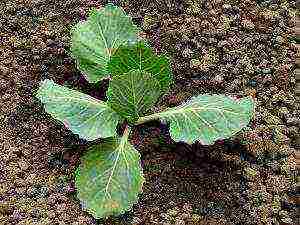
The soil on which the cabbage will be grown in the greenhouse should be well fertilized, dense, loamy and retain moisture well. It is necessary to regularly loosen the soil with fertilizing with manure solution.
The temperature range for growing cabbage is from 5 to 20 ° C. Young seedlings need additional lighting. During the formation of the head, the plant needs a lot of moisture.
Harvesting
In early varieties of cabbage, heads of cabbage appear about 55-60 days after the seedlings were planted, that is, in late June - early July. Ripening of heads of cabbage is not simultaneous, therefore, they need to be removed in several stages, cutting off with a sharp knife. In this case, 2-3 leaves and a stump up to 2 cm long are left.
Important rules
When thinking about how to grow early cabbage, first of all, you need to take care of the quality of seedlings, and for this you need to remember several important points:
one.Before sowing seeds, they must be prepared to avoid contamination of plants with infectious diseases.
2. The potting mix used should not be heavy. If soil from the garden is used, it must first be cold treated on the street or on the balcony, heat treatment is also necessary. The best option is to purchase a special ready-made mixture.
3. It is very important to observe the sowing time. Early cabbage is sown in mid-March. To extend the harvest time, it can be sown after two to three days for two weeks.
4. The container with seedlings should be located in a place where there is enough sunlight. Otherwise, pulling out of seedlings may occur. Additionally, fluorescent lighting is required in order to achieve a total daylight hours of 12-14 hours.
5. After the first true leaves have appeared, the seedlings need to be hardened. In addition to low temperatures, seedlings are hardened with bright light. To do this, it must be taken out into the street. This helps to avoid stretching the seedlings.
6. Watering should be moderate to prevent root rot. For irrigation, settled water with a temperature of 22-23 ° C is used.
7. Before moving the seedlings to the site, do not water it. Plants that are slightly wilted do not break as much.
Compliance with such simple rules will allow you to get an excellent harvest of this useful crop.
How to grow a huge cabbage?
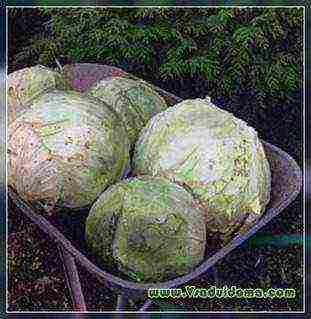 Many gardeners refuse to grow this crop, considering it overly whimsical. I have developed a certain strategy, thanks to which the cabbage succeeds every year.
Many gardeners refuse to grow this crop, considering it overly whimsical. I have developed a certain strategy, thanks to which the cabbage succeeds every year.
1. After checking many varieties of cabbage, I settled on a variety Belarusian 455... I have been growing it successfully for more than one year. It is excellent in salting, and in the conditions of a city apartment, heads of cabbage can be preserved until January.
2. The next step to success is good seedlings... But you can't grow her at home - here she stretches, grows weak. Therefore, I sow the seeds on April 6, either in a greenhouse, covering it with a non-woven material to protect it from frost, or in a box without a bottom and a lid, sowing 3 seeds per hole. I cover the box with glass or 5-liter plastic bottles (in this case, the sowing period is May 1-10). Why don't I put it in a permanent place right away? So it is possible to select the most powerful plants and not waste energy on weed control over a large area.
3. Sow cabbage is very late - in my opinion, this culture does not tolerate transplanting well. But if you transplant it a small one with a large clod of soil, the root will not suffer, and the cabbage will not "notice" that it has been transplanted.
At the end of May, when the frosts stop, I plant the cabbage in a permanent place according to the 90 × 90 cm scheme.It needs space to freely spread the leaves.
4. Well when planting, I make it large, so that the earth from it fits into a 10-liter bucket. I put 1 bucket of compost (at least 7 liters) at the bottom of the pit - cabbage has a good appetite, so you shouldn't spare compost or humus. I also add 1 glass of ash there, pour out 5 liters of water and wait for the water to be absorbed, then mix it with the ground, digging in around the circumference of this hole, as if expanding the future feeding area. A very necessary element for the development of any plants, including cabbage, is superphosphate. It is best to apply it in the fall, but if it was not possible to do this, then in the spring it is better to apply this fertilizer in the form of root dressing somewhere three weeks after planting the seedlings.
See also: Growing cabbage - early, middle and late varieties (conveyor)
5. Top dressing I cook like this: 3 tbsp. I dissolve tablespoons of superphosphate in a small amount of warm water, then pour it into a 10-liter bucket and stir. It dissolves slowly, 1-2 hours, but then an insoluble residue remains at the bottom. However, this is no longer important. 10 liters is enough for three plants (I pour it out in the area of the alleged location of the roots). If the superphosphate is double, then the rate is halved -1.5 tbsp. spoons.
Having planted the plants, I sprinkle the earth that was in the bucket with a roller around the cabbage. It will come in handy after a while for hilling. I plant the cabbage deep, up to real leaves, after removing the cotyledons. Between the plants, you can plant onions on greens: in the first months there will be a lot of free space in the garden.
It is very good to put arcs with covering material over the cabbage and not remove for quite a long time. In such conditions, cabbage takes root well, grows actively, does not suffer from pests.
6. Further care consists in watering and loosening... I loosen the soil quite often to provide good oxygen access to the roots. It is easy to see that after each loosening, the cabbage grows sharply.
7. A month after planting I give the first feeding. It is best to use liquid mullein, diluted 1:10, 1 liter per plant, or prepare a green dressing. To do this, I put 2/3 of the cut grass in a container, fill it with water, close it with a lid and leave it for 10 days. Then I use this top dressing, diluted with water in a ratio of 1:10, 1-2 liters per plant (the dose depends on the age of the cabbage). I spend such feeding the entire period of growing cabbage once every 3 weeks, if the plants are delayed in development, then more often, once every 2 weeks.
8. It is important not to forget about watering: cabbage needs to be watered rarely, but accurately. Therefore, around each plant I make a groove for watering and pour 1 bucket of water under an adult plant.
9. In June, 3 weeks after planting cabbage, its first time hilling... Hilling will have to be carried out several times throughout the season. This is an important part of agricultural technology, allowing a large root system to develop (we want to grow a huge cabbage!).
10. In June, the first pests cabbage. If you do not fight them, all the cabbage leaves will be in small holes, and you will have to forget about the big harvest. I have a good tool that has been helping out for years. I dilute 2 tbsp in 10 liters of water. tablespoons of 70% acetic acid (exactly 2 tablespoons, no less, otherwise there will be no expected result) and water the cabbage leaves from the watering can with this solution.
I fight caterpillars in an unusual way. We attract birds to the site, and they solve the problem of caterpillars. We begin to feed the birds in early spring with cereals and bread, which we collect in winter, soak it and put it in an old frying pan.
With this care, cabbage grows well, and by the time of harvesting, large heads of cabbage stand one to one. I do not break off the leaves, only those that lie on the ground. And when harvesting heads of cabbage, we easily cut the stump with a garden saw.
See also: White cabbage: early and late varieties, care and seedlings.
Another interesting question, how to save cabbage until January in an urban setting... It is easy to find a cool place at the dacha - this is a dressing room, a garage, and a barn. There we keep the heads of cabbage as long as possible, and then we transport them to the city and store them on the balcony. As the snap gets colder, I cover the cabbage with a blanket, and in severe frosts I add more shelter (old jackets and rugs are used). Under such a fur coat, cabbage is well preserved.
Below are other entries on the topic "Cottage and garden - do it yourself"
Simple white cabbage: benefits and properties: Useful properties of white cabbage Today in ... Cabbage variety Hope - growing: How do I grow cabbage in ... Growing cabbage on spunbond - my reviews and advice: How to grow cabbage on spunbond ... Cauliflower (photo) - growing in open field: How to grow cauliflower in ... Cultivation of ornamental cabbage - what kind of plant is it: What is ornamental cabbage and ... Cauliflower variety Violet (photo) - reviews, planting and care: Growing cauliflower variety Violet Tsvetnaya ... Cabbage variety Buffalo heart: Cabbage "Buffalo Heart" This is quite rare ...
Subscribe to updates in our groups.
Let's be friends!
Early cabbage often decorates the beds of avid gardeners, because it allows you to enjoy fresh salads and replenish the supply of vitamins in the body even before other vegetables appear. This culture is distinguished by good germination and productivity, delicate taste and a lot of useful properties.
Being cold-resistant and not very demanding in care, early cabbage will delight you with a rich harvest and diversify the menu of summer residents already at the beginning of summer. In our article we will tell you about planting early cabbage through seedlings, after all, it is in this way that you can plant ready-made seedlings in open ground with the first heat, and get the earliest possible harvest.
When to sow early cabbage for seedlings, timing
Traditionally, sowing cabbage for seedlings begins in the first half of March and after 2 months the ripe sprouts are transferred to the beds. In the middle lane, where a really warm spring does not come until May, seeds are planted from mid-March, so that the "resettlement" of seedlings to the garden falls on a period when there is no longer a threat of severe frosts.
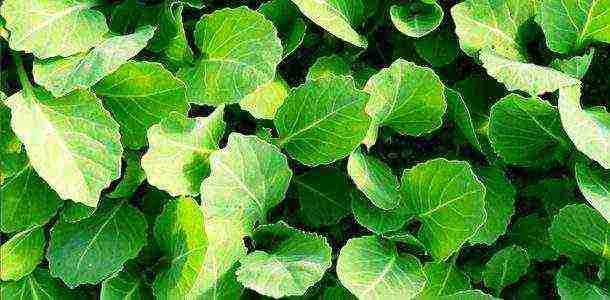
In the southern regions, on the contrary, it is possible to start sowing a little earlier - from mid-February, especially if heated greenhouses are prepared for seedlings.
More specifically, the timing of sowing early cabbage for seedlings can be calculated based on the planned date of planting plants in open ground. Usually, seedlings are transferred to the beds at the "age" of 45-50 days, this period includes the period from seed germination to the appearance of 4-5 true leaves on the shoots. To determine the time of sowing cabbage, you need to subtract 40-50 days from the desired date of planting seedlings in the garden.
back to contents ↑ Purchase of seeds and seedbed preparation
What kind of harvest of early cabbage can be grown depends largely on the seeds, so you should approach them responsibly. It is better to purchase such products in special stores for gardeners and be sure to check the expiration dates. Seeds on the market can be bought cheaper, but in this case, there is a high probability that they are defective or improperly stored and damp.
Among the most popular varieties of early cabbage, it is worth highlighting:
- June;
- "Ditmarskaya";
- "Legate F1";
- "Kraft";
- "Kazachok F1";
- "Present".
Such hybrids ripen, on average, in 120 days and already at the beginning of summer they delight with fresh and juicy heads of cabbage. Moreover, these varieties are quite frost-resistant and productive.

For sowing, only the largest seeds should be selected that will definitely sprout. This task can be simplified by placing the seed material in a 3% saline solution for 5-10 minutes: the full-weight fractions will settle to the bottom, and the empty ones will float. Selected seeds should be disinfected to reduce the risk of fungal infections in the seedlings. To do this, pour the seeds with water heated to 50 degrees for 20 minutes, and then cold for 1 minute. Next, they need to be immersed for 12 hours in a solution of trace elements, then rinsed, dried and left in the refrigerator for a day.
back to content ↑ How to plant correctly
To plant seeds of early cabbage, you need to prepare a special soil mixture (substrate), which consists of peat, sand and turf in proportions of 1: 1: 1. The soil from the garden is not suitable for growing seedlings, since it can harbor cruciferous diseases, moreover, it may not be fertile and light enough.

As for the containers, their choice depends on whether the seedlings will be grown with or without a pick. In the first case, it is necessary to acquire seedling boxes 5-7 cm high, as well as individual containers (disposable cups, pots, peat tablets, cassettes with separate cells, etc.) for further transplanting the sprouts. When growing without picking, you can do without seedling boxes.
Sowing also depends on these two criteria:
- With a pick - first, cabbage is planted in seedling boxes in rows, embedding them in the substrate to a depth of 1-1.5 cm and with a distance between seeds of 1-2 cm.When the seedlings grow up a little and get stronger, which occurs about 10-12 days after planting, then the seedlings need to be transplanted (dived) into separate containers with fresh substrate. This must be done very carefully, trying not to damage the root system of the plants.
- Without picking - the seeds are immediately sown in individual containers, planting 2-3 seeds in each of them. If the seed is of high quality, then in each "sector" 2-3 seedlings should grow. When the sprouts get stronger, they will need to be thinned out, removing the weakest plants and leaving in each "section" 1 of the strongest seedling.
back to contents ↑ Proper care

Seedling care includes:
- Temperature regime - immediately after planting the seeds, in the room where the seedlings are placed, the temperature should be at + 18-20 degrees, and when shoots appear, it must be reduced to + 7-10 degrees: the coolness will somewhat slow down the growth of the seedlings and prevent them from stretching too much ... After 2 weeks in this mode, the temperature can be increased to + 12-14 degrees.
- Lighting - daylight hours for seedlings should last 12-14 hours, so if there is not enough natural light, a fluorescent lamp should be installed above the sprouts.
- Watering - cabbage loves moisture, however, waterlogging of the soil is contraindicated for it, therefore, the seedlings should be watered only when the top layer of the substrate begins to dry out. It is better to use warm water for irrigation.
- Top dressing - you need to feed cabbage seedlings 2 or 3 times, depending on the way it is grown. If the seedlings grow without picking, then they should be fed 2 times: in the phase of 2 true leaves and before hardening. If the seedlings are grown with a pick, then one more top dressing should be carried out 7-8 days after transplanting the shoots into separate containers. Top dressing should be foliar: spray the solution of trace elements on top of the plants.
- Hardening - before planting in open ground, seedlings must be accustomed to direct sunlight, wind and other environmental factors in order to increase their viability. To do this, you need to take out the seedlings for several hours in the open air 2 weeks before the "resettlement".
Seedlings can be transplanted into open ground when 4-5 true leaves appear on the sprouts. Plants should be healthy, rich green, with no signs of disease or damage.
Sowing early cabbage for seedlings and further caring for seedlings is within the power of every gardener. Having created optimal conditions for the development of plants, you can even get strong sprouts in an apartment, which will result in a rich harvest of tasty and healthy cabbage.
back to contents ↑ Video tip
If you find an error, please select a piece of text and press Ctrl + Enter.
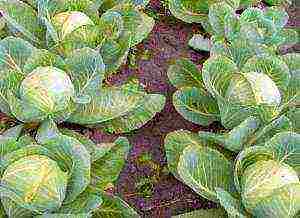 Changes in the climate are making it difficult to grow vegetables. How to care for white cabbage in conditions of non-standard natural phenomena and get a good harvest?
Changes in the climate are making it difficult to grow vegetables. How to care for white cabbage in conditions of non-standard natural phenomena and get a good harvest?
White cabbage is a cold-resistant, light-loving plant. For its full development and maturation, a day of light with a duration of at least 13 hours is required. Depending on the region, early and mid-season varieties ripen no earlier than 70 days or more. How to properly grow white cabbage to get a good harvest in any region? To do this, you must adhere to some rules.
How to choose and prepare white cabbage seeds?
The growing region plays a major role in the selection of seeds for sowing. The farther north the site is, the more early ripening varieties you need to choose. On the package, the description contains the timing of sowing and the approximate harvest of the crop.
But, as a rule, these data are indicated in the case of strict adherence to the agricultural technology of care and cultivation. Such violations, as well as a failure in climatic conditions - drought, heavy and prolonged rains, prolonged frosts - negatively affect the agricultural technology of growing white cabbage.
The main task of preparing white cabbage seeds is to improve their germination and further healthy development of sprouts. For this, a number of events are carried out with seeds:
- Calibration;
- Hardening;
- Stratification - keeping wet seeds for a certain amount of time at low temperatures;
- Soaking in a disinfectant solution;
- Warming up;
- Processing with microelements;
- Germination.
The process can be described as follows. After calibration, dry white cabbage seeds are placed in hot (about 45-50 C) water for 15 minutes. Then it is dipped in cold liquid for a minute. A solution with trace elements is brought in and put into it for 12 hours. Then it is washed with clean water and placed in a refrigerator for a day. It remains to dry the seeds and sow.
Soil preparation for sowing and seedlings
For seedlings, seeds are sown in boxes. But to make the plants easier to transfer the transplant into open ground, it is better to sow each seed in a separate container.
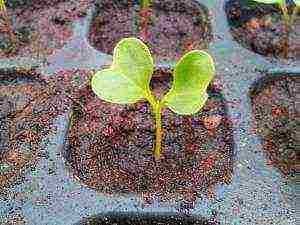 They can be bought if it is not possible to independently equip the landing cassettes. In this case, the root system is not stressed, since it is carefully moved with a lump of earth into the prepared hole. Although cabbage is not picky about replanting, this method of planting will allow you to harvest earlier.
They can be bought if it is not possible to independently equip the landing cassettes. In this case, the root system is not stressed, since it is carefully moved with a lump of earth into the prepared hole. Although cabbage is not picky about replanting, this method of planting will allow you to harvest earlier.
When planning a place for planting white cabbage seedlings, it is worth remembering which culture was its predecessor. It is desirable that onions, green manures, cereals, carrots, cucumbers and potatoes grow here before.
It is necessary to exclude the planting of a vegetable crop in the place of the cruciferous family - radishes, radishes, various types and varieties of cabbage, beets, turnips, as well as tomatoes.
The plot for cabbage is prepared in advance, preferably in the fall. If the soil is acidic, then lime substances are added. Neutral soils are most favorable.
In the spring, organic and mineral fertilizers are added per 1 m2:
- Wood ash - 3-4 glasses;
- Overripe organic matter - 1 bucket;
- Urea - 1 tablespoon;
- Superphosphate - 2 tablespoons.
The soil is dug up, weeds are removed from the roots and the beds are prepared by applying fertilizers. There can be several options for the formation of beds, it all depends on the preferences and physical strength of the gardener. Planting in boxes, a separate bed for each seedling, rectangular beds in 1 and 2 rows, etc. It is important that when watering the water does not flow to one bush, but is evenly distributed over the entire surface, irrigating all plants.
If dry winds prevail in the region or there are problems with water, timely loosening and mulching will help to prolong soil moisture.
How to properly plant white cabbage seedlings
 In the prepared beds, holes are made with a hoe. It is important that their depth is slightly greater than the height of the plant's root system. If the hole is larger than necessary, then a little earth is added to it. The main thing is that the depth is not less than the root. Otherwise, the plant will fall and root poorly.
In the prepared beds, holes are made with a hoe. It is important that their depth is slightly greater than the height of the plant's root system. If the hole is larger than necessary, then a little earth is added to it. The main thing is that the depth is not less than the root. Otherwise, the plant will fall and root poorly.
Another important point. When planting a plant, you need to ensure that the rosette of the cabbage is not covered with earth. Otherwise, its growth will stop and the culture will die.
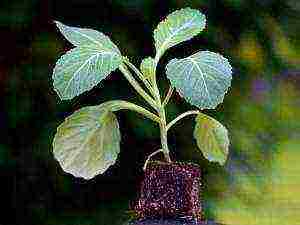 Before planting white cabbage, water it. If the seedling sits in a separate pot, then after the soil has become saturated with moisture, it is carefully turned upside down with one hand, grasping the upper surface of the container with the palm of the other hand. In this case, a stem should remain between the fingers. By gently shaking the pot, a lump of earth along with the root will come out and remain intact in the palm of your hand. It remains only to turn it upside down, put it in the hole, sprinkle it tightly with earth and water it.
Before planting white cabbage, water it. If the seedling sits in a separate pot, then after the soil has become saturated with moisture, it is carefully turned upside down with one hand, grasping the upper surface of the container with the palm of the other hand. In this case, a stem should remain between the fingers. By gently shaking the pot, a lump of earth along with the root will come out and remain intact in the palm of your hand. It remains only to turn it upside down, put it in the hole, sprinkle it tightly with earth and water it.
Planting scheme for early varieties - 40X25 cm, medium and late - 40X60 cm.
If a strong heat is expected after planting seedlings, then caring for white cabbage, in addition to mulching the soil, will consist in protecting young leaves from sunburn. To do this, you can make a small canopy, the basis of which is a wooden or metal frame, covered with non-woven material or any light-colored fabric.
Necessary conditions for growing white cabbage
To get a good harvest, it is important to maintain the basic conditions for growing cabbage:
- Optimum air and soil temperature during the growing season and ripening; otherwise, it will lead the plant to bloom and other problems;
- Adequate amount of light; do not plant plants near trees or in other shaded areas; the cabbage will stretch out; this will cause poorly tying a fork or head of cabbage;
- Watering; cabbage is very demanding for timely abundant watering; but it is worth remembering that excessive daily moisture will lead to premature cracking of the fork;
- Soil cultivation - loosening, mulching will reduce the number of irrigations and provide free air access to the root system;
- Mineral and organic fertilizing;
- Protection from pests and diseases.
When growing white cabbage, you need to take into account the cold-tolerant qualities of the plant. For example, frost resistance depends on the age and variety of the crop. For the emergence of sprouts, 2-3 degrees above zero are enough. But friendly shoots will appear in 4-5 days at a temperature of about 20 degrees Celsius.
Hardened seedlings with a developed root system or planted in the ground no earlier than 10-14 days can cope with the effects of night frost. In this case, the thermometer indicator should be at least 3-5 degrees below zero. The optimum air temperature for growing seedlings is 13-15 C, and the soil is 2-3 degrees lower.
If it is difficult or impossible to maintain the necessary conditions outdoors for the development and cultivation of white cabbage, then it is worth taking care of the construction of a greenhouse. It is important to choose varieties bred for indoor cultivation. This will avoid many diseases, especially fungal, characteristic of the cruciferous family.
Here you can see varieties of white cabbage with a photo.
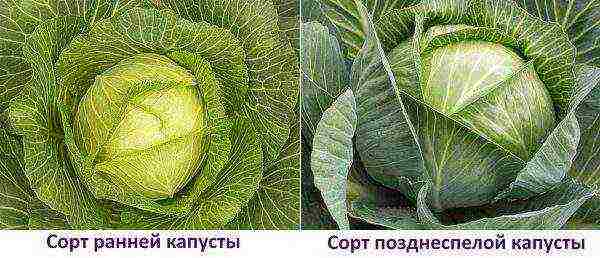
What is the peculiarity of growing cabbage in a seedless way?
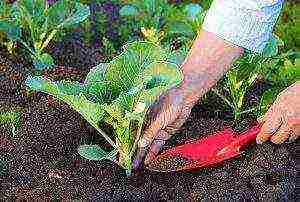 White cabbage grown in a seedless way gives a high yield 10-12 days ahead of schedule. Seeds are sown 3-4 in one nest and immediately to a permanent place. What is the peculiarity of this method?
White cabbage grown in a seedless way gives a high yield 10-12 days ahead of schedule. Seeds are sown 3-4 in one nest and immediately to a permanent place. What is the peculiarity of this method?
It is necessary to be very careful when choosing a site, because completely unprotected crop sprouts will appear there. Protection from pests and diseases is somewhat more difficult than in greenhouse conditions. Before planting, the soil should be cleared of the roots of weeds and harmful insects as much as possible. White cabbage grown in this way is more hardy, seasoned and fruitful.
Seeds are pretreated and sown in well-prepared soft moist soil, sprinkled with peat. After the emergence of seedlings, the plants are thinned out, leaving the strongest.
It's easy to grow a good harvest of cabbage (video)
